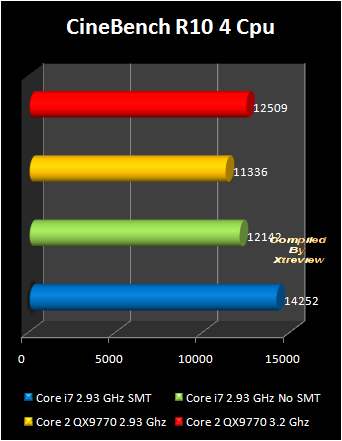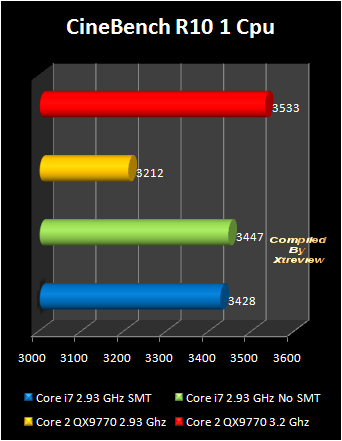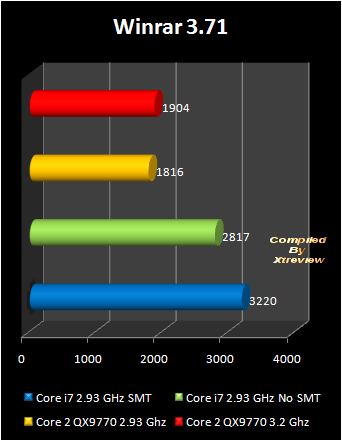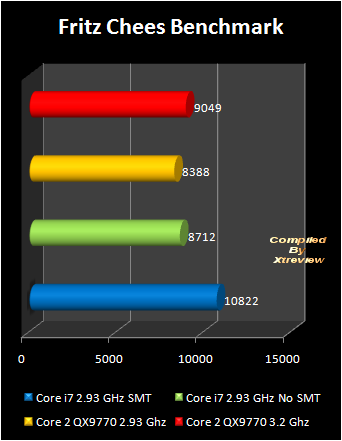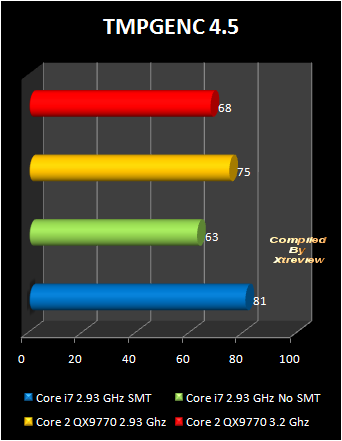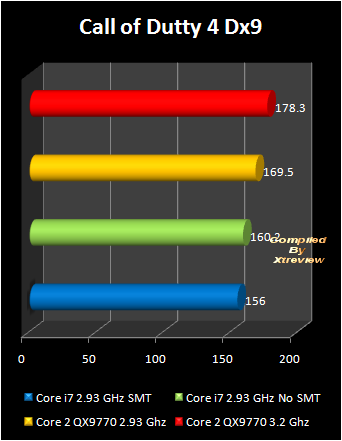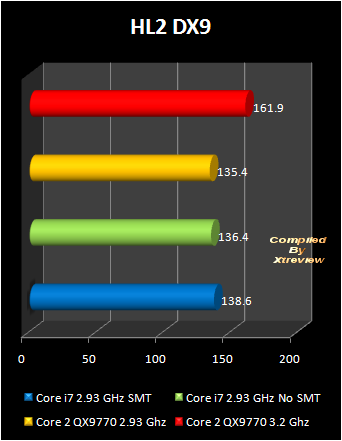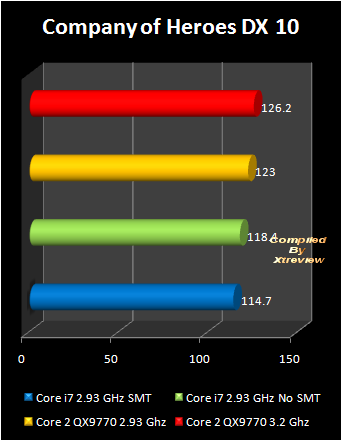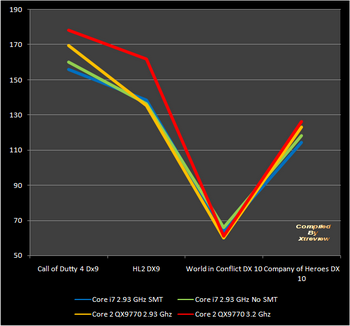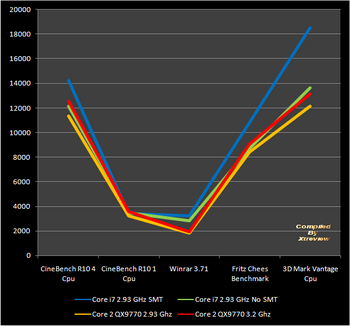OOPS! You forgot to upload swfobject.js ! You must upload this file for your form to work.
Intel core i7 Single vs Dual vs three channel memory SMT on Vs SMT OFF
![]()
|
xtreview is your : Video card - cpu - memory - Hard drive - power supply unit source |
|
|||
|
|
||||
 Recommended : Free unlimited image hosting with image editor
Recommended : Free unlimited image hosting with image editor
|
POSTER: computer news || INTEL CORE I7 SINGLE VS DUAL VS THREE CHANNEL MEMORY SMT ON VS SMT OFF |
DATE:2008-10-11 |
|
|
One of the main update in LGA 1366 platform are the passage from the dual-channel memory to the three-channel, plus the passage of the memory controller directly in the processor.
However, the appearance of the third memory channel created an additional problems. First, it is necessary to buy memory in the three-channel complete sets. In the second place, six slots DIMM on the motherboard will occupy much more place. Associate tested the processor core i 7-940 (2.93 GHz) with different memory channels configuration : Here is the configuration used : and Using Windows Vista ultimate SP1 and Forceware 177.98 for Vista  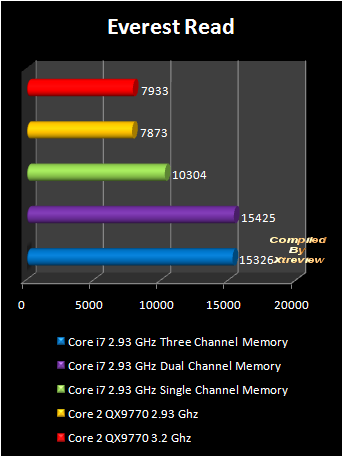 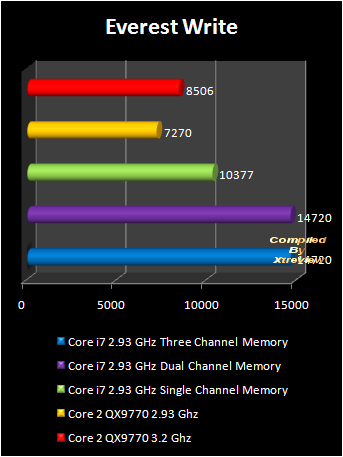 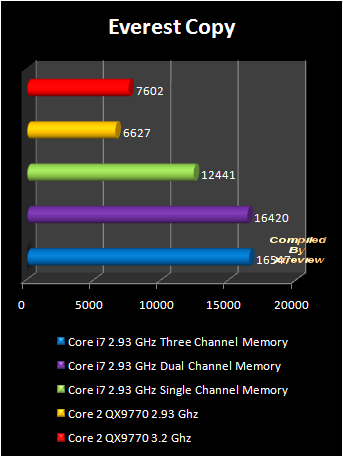 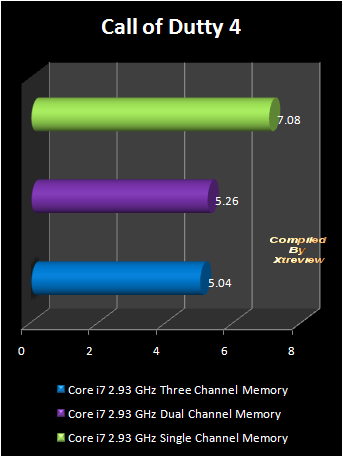 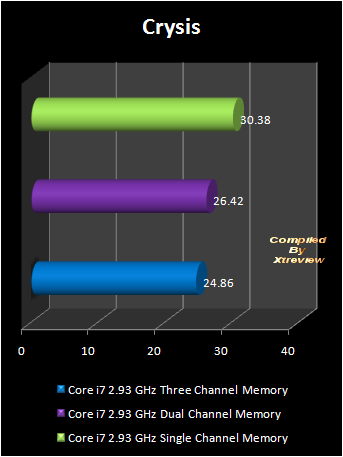 Increase after transfer from one memory channel to two is the most noticeable, moreover this concerns not only games. However, difference between the performance of dual and three channel is very small. In this case lynnfield processors with the dual-channel memory controller will be barely inferior to Bloomfield. However, with increase in the processor frequency the memory capacity will also grow, and the third channel open its potential.
Simultaneously associates tested the effectiveness of hyper-Threading. As is known, bloomfield processors can support to eight virtual thread, although physically they possess only four cores . Contemporary applications, hardly use the potential of four cores. In a number of tests, with hyper-Threading enabled the processor performance is reduced . However, in archiving, rendering and chess benchmark , hyper-Threading boost the performance . Related Products : | ||
|
|
||
|
xtreview is your : Video card - cpu - memory - Hard drive - power supply unit source |
|
|
|
|
||
|
Xtreview Support  N-Post:xxxx Xtreview Support        |
INTEL CORE I7 SINGLE VS DUAL VS THREE CHANNEL MEMORY SMT ON VS SMT OFF |
| Please Feel Free to write any Comment; Thanks  |
Twelve-core Core i9-7920X lost the lid in front of the photographic lens (2017-09-06)
Eighteen-core Core i9-7980XE overclocked to 5.0 GHz (2017-09-06)
The six-core processor Intel Coffee Lake lit up at a Chinese auction (2017-09-06)
The six-core processor Intel Coffee Lake has conquered the frequency of 5.0 GHz (2017-09-05)
One more copy of Core i9-7960X has overcome a boundary of 5000 points in Cinebench R15 (2017-09-04)
MediaTek announces 8-core 16-nm mobile chips Helio P23 and Helio P30 (2017-08-30)
Core i9-7960X at 5750 MHz in XTU (2017-08-30)
Core i9-7960X at 5750 MHz set a new record for XTU (2017-08-28)
Core i9-7960X and Cinebench R15 record now at 5639 MHz (2017-08-27)
Intel Core i7-8700K seen in the companys motherboard ASRock Z370 Pro4 (2017-08-26)
Leaks on the performance of Intel Core i3-8350K Coffee Lake (2017-08-24)
Sixteen Skylake-X cores and four GeForce GTX 1080 Ti a couple of fresh records (2017-08-23)
3DMark Vantage Performance improved by increasing the frequency Core i9-7960X to 5.6 GHz (2017-08-22)
Six-core processors Intel Coffee Lake should be released in October (2017-08-22)
At 5.5 GHz, the Core i9-7960X helped to update the records of 3DMark Fire Strike (2017-08-19)
Sixteen-core Core i9-7960X in Cinebench R15 (2017-08-17)
The world record Unigine Heaven Xtreme is updated with the help of Core i7-7740X and GeForce GTX 1080 Ti (2017-08-14)
For the new absolute Cinebench R15 record, 88 Broadwell-EX cores (2017-08-10)
For internal tests of Radeon RX Vega 64, AMD used Core i7-7700K (2017-08-08)
Core i9-7900X at 5960 MHz has updated the GPUPI for CPU 1B (2017-08-08)
![]()
To figure out your best laptops .Welcome to XTreview.com. Here u can find a complete computer hardware guide and laptop rating .More than 500 reviews of modern PC to understand the basic architecture


7600gt review
7600gt is the middle card range.
We already benchmarked this video card and found that ...

 geforce 8800gtx and 8800gts
geforce 8800gtx and 8800gts  Xtreview software download Section
Xtreview software download Section  AMD TURION 64 X2 REVIEW
AMD TURION 64 X2 REVIEW  INTEL PENTIUM D 920 , INTEL PENTIUM D 930
INTEL PENTIUM D 920 , INTEL PENTIUM D 930  6800XT REVIEW
6800XT REVIEW  computer hardware REVIEW
computer hardware REVIEW  INTEL CONROE CORE DUO 2 REVIEW VS AMD AM2
INTEL CONROE CORE DUO 2 REVIEW VS AMD AM2  INTEL PENTIUM D 805 INTEL D805
INTEL PENTIUM D 805 INTEL D805  Free desktop wallpaper
Free desktop wallpaper  online fighting game
online fighting game  Xtreview price comparison center
Xtreview price comparison center Lastest 15 Reviews


Rss Feeds
Last News
- The new version of GPU-Z finally kills the belief in the miracle of Vega transformation
- The motherboard manufacturer confirms the characteristics of the processors Coffee Lake
- We are looking for copper coolers on NVIDIA Volta computing accelerators
- Unofficially about Intels plans to release 300-series chipset
- The Japanese representation of AMD offered monetary compensation to the first buyers of Ryzen Threadripper
- This year will not be released more than 45 million motherboards
- TSMC denies the presentation of charges from the antimonopoly authorities
- Radeon RX Vega 64 at frequencies 1802-1000 MHz updated the record GPUPI 1B
- AMD itself would like to believe that mobile processors Ryzen have already been released
- AMD Vega 20 will find application in accelerating computations
- Pre-orders for new iPhone start next week
- Radeon RX Vega 57, 58 and 59: the wonders of transformation
- ASML starts commercial delivery of EUV-scanners
- The older Skylake processors with a free multiplier are removed from production
- Meizu will release Android-smartphone based on Helio P40
- AMD Bristol Ridge processors are also available in American retail
- The fate of Toshiba Memory can be solved to the next environment
- duo GeForce GTX 1080 Ti in GPUPI 1B at frequencies of 2480-10320 MHz
- New Kentsfield overclocking record up to 5204 MHz
- Lenovo released Android-smartphone K8

HALO 3 HALO 3 - Final Fight!

PREY Prey is something you don t often see anymore: a totally unigue shooter experience.

computer news computer parts review Old Forum Downloads New Forum Login Join Articles terms Hardware blog Sitemap Get Freebies

